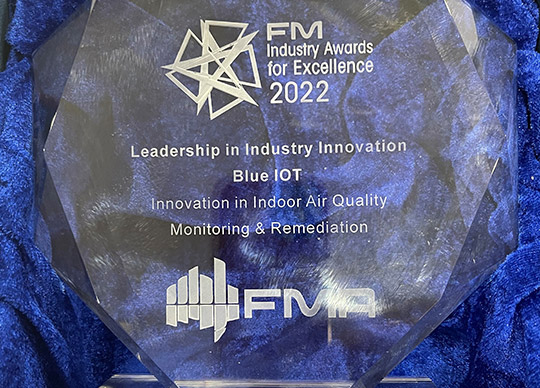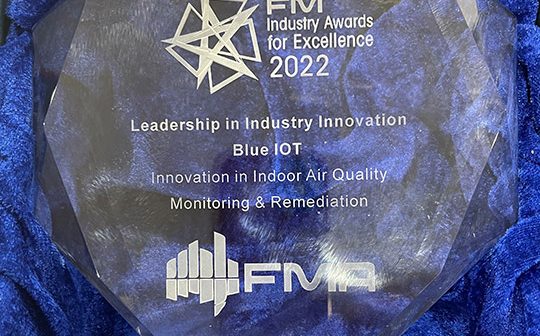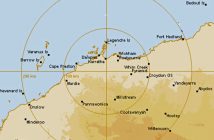
Blue IoT was invited by Somerset College to initially help with the monitoring of Indoor Air Quality (IAQ) in one of the classrooms within a classroom block.
The Gallus building in question accommodates eight classrooms which were expanded and renovated in 2016.
Each classroom accommodates up to thirty students and one teacher during class times.
Initially focusing on measuring the Total Volatile Organic Compounds (TVOCs) and Carbon Dioxide (CO2) by placing a wireless cyber secure IAQ (Indoor Air Quality) sensor in one classroom, it was quickly realised the building had a ventilation issue from the CO2 data gleaned.
Upon our advisement the College ordered more IAQ CO2 sensors which were deployed into all classrooms in the building and across the campus to monitor the CO2 levels in order to gain an understanding of the level of the problem and how to put in place a mitigation strategy to reduce the CO2 levels to a safe standard.
Upon researching safe CO2 levels for school classrooms, it is deemed any reading over 1,100 parts per million (ppm) has a potential negative impact on both the student and teacher.
CO2 levels of 1,000 to 2,000 ppm for extended periods can cause drowsiness and an inability to concentrate properly. Headaches and other physical effects described above can begin at between 2,000 and 4,000 ppm.
More serious, and potentially toxic, effects can happen when CO2 levels are above 5,000 ppm. Additionally, the ability for a student to absorb information is impacted the higher the CO2 levels are thus impacting the student’s ability to perform well in exams.
These older classrooms under study had high CO2 levels, reaching above 3,000ppm at peak accumulation during a class.
To design and implement a solution that consistently ventilate each classroom during class time to ensure CO2 levels are kept below 1100ppm. To expand the use of CO2 measurement and monitoring as a tracer to test ventilation levels in all classrooms.
To ultimately provide a healthier and more optimal teaching and learning environment for students and teachers to perform at their best. To provide peace of mind to parents and other stakeholders that these measures of improving Indoor Air Quality are contributing to the health, wellbeing and safety of their children.
Initialised a pilot IAQ monitoring program throughout most locations on the school campus. With that data in hand, a remediation program and study in four classrooms to compare and measure CO2 levels in the Gallus building was implemented in May 2022.
This included the installation of door louvres, window and roof fans operated remotely by Encompass Blue campus wide LoRaWAN system at the College utilising five outdoor gateways in order to remotely monitor, measure and control IAQ in four classrooms.
The observed data pre installation during May 2022 pre installation, showed CO2 levels that occasionally peaked over 3,000ppm.

In rooms without ducted systems and more particularly those with split systems, CO2 levels sharply increase as soon as students enter classrooms with virtually all rooms breaching the 1,100ppm threshold within one hour of the start of classes.
The pilot project shows CO2 levels will rise and then be controlled to a much safer threshold level with active remediation. The exhaust fans are really only effective 100% if there is the ability to draw in fresh outside air through either an open window or door.
Otherwise the exhaust fan struggles to exhaust the stale air effectively due to negative air pressure.
Solution is to install large louvres in the classroom doors which we recommended and then installed.
This allows for adequate air throughput to be pulled in through the fixed door louvres by the fan and easily exhaust the contaminated air.
Small quiet fans were used on the ground floor classrooms while roof EC fans with ceiling ducts were used for those on the first floor.
These are all run during class times. The bottom line is that post the installation and commissioning of Blue IoT’s cloud based remote control Encompass Blue smart schools platform suite, it was observed that more than 65% of CO2 was successfully exhausted based on the clear evidence provided.
Air circulation testing showed that once a room was full of smoke, the system would take 30 to 45 minutes to completely clear the room.
By running the exhaust fans from the start, before too much CO2 accumulation, we have been able to greatly slow the increase of CO2 while we slowly exhaust the excess as indicated in the charts above.

“The Somerset College Indoor Air Quality project is a joint initiative between the College and Blue IOT that brings together the latest in air monitoring and control technologies to deliver enhanced health and wellbeing to students and staff. Extensive monitoring and measuring of classroom CO2 levels revealed remedial ventilation strategies were required, especially in the older facilities. The installation of an IoT cloud based remote control ventilation solution has resulted in an impressive 65% (average) reduction in CO2 levels in the affected classrooms, and has dramatically improved ventilation in these spaces. This initiative and achievement is to be applauded.” Distinguished Professor Lidia Morawska, PhD.
Blue IoT have worked very closely with the College’s facilities management team since December 2020 for us to achieve our objectives and deliver the outcomes promised.
On numerous occasions we have had to work outside of normal hours to avoid disrupting classes and the facilities team have provided access and assistance to allow us to gain invaluable knowledge and insight into key aspects of the College buildings and Campus infrastructure.
Their knowledge and professionalism have made this project much easier to implement and we are continuing our partnership with them in future projects: in water leak detection, energy management and asset tracking.
In an office or education environment, Carbon Dioxide (CO2), occurs as a result of people breathing, whilst Total Volatile Organic Compounds (TVOCs) are generated by fumes from paints, building materials, mould, pollution etc.
In some circumstances, it can also be generated by faulty or poorly designed HVAC systems. Normal concentrations of CO2 are typically between 400 and 1,000 ppm for occupied indoor spaces with good air conditioning and ventilation.
When increased levels of CO2 occurs indoors, (usually due to poor ventilation), symptoms listed in the previous section will indeed occur.
Scientific Studies have linked high CO2 Levels with Poor Employee Health and Productivity as well as a much higher risk of catching viruses and bacteria from others in the building.
It has also been proven that when ventilation is poor, the risk of catching COVID-19, Influenza and other viruses and bacteria increase dramatically.
The ideal indoor environment is one with a substantial amount of fresh air replacing the stale, contaminated air inside. In indoor environments such as classrooms, it is important that quality ventilation and monitoring systems are in place.
Monitoring CO2 as a tracer for adequate ventilation as the first stage was a vital place to start our journey in how a building breathes and impacts its occupants.
Once the data revealed an air quality issue, the remediation strategy was designed, planned, implemented, tested and confirmed with an average 65% reduction in CO2 levels in classrooms.
In actual terms, the charts above show that the average levels reduced to well under 800ppm with a few peaks above 1,300ppm.
This means we are delivering a much safer and healthier indoor air environment that would reduce the risk of catching viruses and bacteria and thus reduce sick days while enhancing student concentration, learning and academic achievement.
The school intends to roll this out in all their older buildings via the existing campus wide LoRaWAN network which has the highest levels of cyber security. The facilities team has visibility and control of every device anywhere, via the Blue IoT web app.
Traditional systems are all manually run and often left on as people forgot to switch off systems.
The innovation and sustainability and safety brought about by Encompass Blue is nothing short of innovative and transformational for the schools, staff, students, the bottom line and the environment.
With health and wellbeing receiving a lot of attention in our current Covid19 climate, improving Indoor Air Quality in all facilities has never been more important than it is now.
Blue IoT is now working with Somerset College to involve students for their STEM subjects and prizes and internships will be offered to students that come up with the best ideas and/or find more gems in the data.
We will be further observing levels of absenteeism and improvements in exam results over the coming months.
The fact is with a proven 65% reduction in classroom CO2 levels, it is expected to result in a reduced level of infection rates, sick days and an increase in health, productivity and academic performance.
What does this mean for the office environment. The same initial process of measuring first must take place as we measure and verify.
After engagement with the local FM, if problems found cannot be remediated by the existing infrastructure, Blue IoT will design a solution that will most likely include indoor air purifiers that can be managed, audited, monitored and controlled by Blue IoT’s Encompass Blue platform.
Blue IoT is a leading-edge smart cities vendor and integrator renowned for ‘Encompass Blue’ – the world’s first IoT smart cities platform suite.
Driven by a Greentech/Proptech and systems thinking 360-degree approach, Blue IoT is at the forefront of sustainable innovation, delivering outstanding results.
Blue IoT is the recipient of the Australian IoT Pioneer Award 2019, the FMA FM Industry Awards for Excellence 2019 for Industry Innovation, the Global FM Highly Commended Award of Excellence in FM 2020, and most recently the AFE (Association of Facilities Engineering – USA) Leadership in Innovation Award 2021 – Nov-2021 and more recently, the ACS CXO Disruptor of the Year for 2022.
Challenging times like the present have acted as a catalyst for advancing smart buildings, cities, and assets to optimise the wellness of people and the planet.
Blue IoT acts on this urgency for sustainability, executing a move towards carbon net-zero by rendering solutions for substantially conserving our planet’s resources, while simultaneously enhancing the human experience.
At the heart of our service is Encompass Blue, which delivers world-leading savings of 20 to 50% of total energy use, maintenance costs, and up to 70% of carbon emissions.
Consolidating an array of functions, this state-of-the-art technology embodies excellence in the cloud, IoT, interoperability, smart sensors & controllers, machine learning, predictive maintenance, and cybersecurity.
Encompass Blue provides a broad, open platform for digital transformation in FM (facilities management), infrastructure, buildings, and smart cities.
Additionally, this technology also facilitates effective Covid-19 risk mitigation services. Notable for its continuous engagement model, Blue IoT is focused on a partnership with its clients, enabling a consistent flow of benefits.






